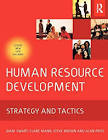| |

Creative New Employee Orientation Programs: Best Practices, Creative Ideas, and Activities for Energizing Your Orientation Program
edited by Doris M. Sims
New employee orientation is the most commonly offered type of training in organizations, yet very few books have been published on the topic. Creative New Employee Orientation Programs is filled with downloadable, customizable training games, sample curriculum, handouts, and checklists used in leading organizations such as Arthur Anderson, Ford, Micron, and Alcatel. Whether creating an orientation program for the first time, enhancing an existing program, or moving orientation on-line, HR pros will find ideas and tools they can use immediately.
More information and prices from:
- US dollars
- Australian Dollars
- Canadian dollars
- British pounds
- Euros
- Euros

Human Resource Development: Strategy and Tactics
by Juani Swart, Clare Mann, Steve Brown and Alan Price
This book examines the factors influencing the effectiveness of an individual's learning,
how people learn and the assessment of training and learning needs, showing the significance of aligning
departmental, group and individual HRD objectives with business goals.
More information and prices from:
- British pounds
- Euros
- Australian Dollars
- US dollars
- Cdn dollars
- Euros
|
|
|
Induction: orienting
the new employee
Starting a new job has been compared with your first day at school. You are bound to be:
- a little nervous, but hopefully enthusiastic;
- keen to impress, but not wanting to attract too much attention;
- anxious to learn quickly, but not wanting to be deluged with names, facts and figures;
- hoping to fit in, but not look too 'new' and inexperienced.
The reception you receive from your employers should anticipate these feelings. After all, the organization has spent
good money hiring you and should treat you as an investment to be nurtured and encouraged.
In reality, however, you are likely to receive an induction or orientation which can be anywhere between
two extremes:
- In at the deep end - expecting you to get on with the job without any real welcome or
information
- Overwhelming - providing you with an avalanche of introductions, site tours, information packs, etc.
What induction is not about
Most large organizations inflict at least some of the following on new hires:
- Handing out the employee handbook - the HR department may be proud of it but it is not going to be an easy
read.
- Introducing the new recruit to everybody in the business - embarrasing at best, and likely
to be off-putting to a new hire who wants to slide into the job quietly. Besides, no-one wll
remember what they have been told nor the names of the people to whom they have been introduced.
- Dishing out even more facts and figures on day 1.
- Doing so in the form of a lecture or presentation - with slides.
- Doing it again on day 2.
- Not giving the employee their own 'home' - workspace, desk, phone, computer.
- Having the immediate supervisor away on vacation, in a continuous series of meetings, or just too busy to be involved.
In her excellent practitioner guide Dynamic Introduction (Gower Publishing, 2003)
Susan El-Shamy (p. 20) describes a typical ineffective induction programme in these words:
"Many of you may be all too familiar with the standard three-hour orientation
programme that has too many inductees crowded into a small, hot room with too few chairs and too
many long-winded speakers. Endless slide presentations may have given way to endless PowerPoint presentations,
but the central goal of getting all the information dumped onto the new employees in the quickest way
may not have changed at all."
These activities run the risk of boring and confusing, rather than helping, the new
employee. Obviously, there is information which new recruits need and paperwork (payroll details, social
security, etc) that has to be done. Also, there is a degree of ritual - a 'rite of passage' -
expected by the new hire, colleagues and the organization. But the process needs to be thought
through, especially in relation to timing, quantity and intensity.
The simple truth is that most people responsible for orienting new employees do not:
- put themselves in the new hire's shoes, i.e. do not take account of just what it is like to
start a new job;
- think of induction as an adult learning process which has to be designed to take account of the ways in which people learn
Susan El-Shamy goes on to argue that 'the goals of the orientation or induction training
programme should be the same as the goals of an entire induction process.' According to El-Shamy, these goals include:
- creating a positive impression
- addressing any new-job regrets
- increasing comfort levels and feelings of belonging
- increasing knowledge of the organization and its policies and procedures
- sharing organizational values, goals and initiatives
- distributing basic staffing and human resource information
- communicating information about the work environment
- sharing job-specific information
Next page:
This article is adapted from the 2nd edition
of , Alan Price (2004), published by Thomson Learning.
More learning articles:
Excerpts from Chapter 5, The Trainer's Handbook
|
|